28 Dwarf Magnolia Trees That Are Perfect for Small Gardens
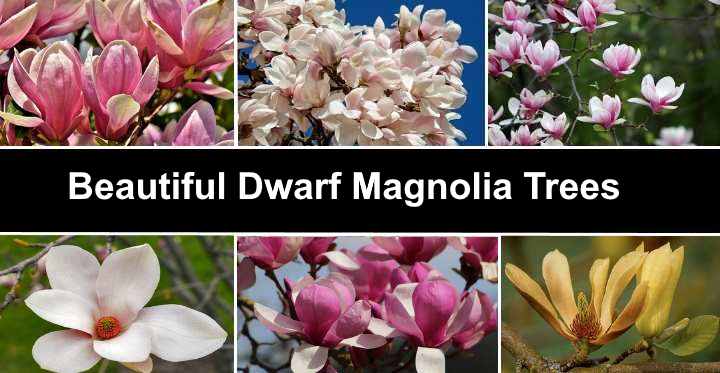
Dwarf magnolia trees add a touch of elegance and beauty to garden landscapes. The stunning flowering trees reach a maximum height of 20 feet (6 m) and have captivating blooms. The large, fragrant flowers and glossy green leaves fill yards with sweet floral aromas and lush foliage. Thanks to their compact size, dwarf magnolias are ideal landscaping trees for small yards or container gardening.
Magnolia flowers are large, fragrant blooms with varying white, pink, purple and yellow hues. The showy flowers can be large, goblet-shaped blooms, star-like flowers, or delicate pinwheel blossoms.
For example, the popular dwarf magnolia ‘Little Gem’ (Magnolia grandiflora ‘Little Gem’) has cup-shaped, fragrant, creamy-white flowers with a compact size. Together with evergreen foliage, they enhance a garden’s aesthetics with year-round beauty, texture, and fragrance.
This article is an identification guide to different types of dwarf magnolia trees. Descriptions and pictures of the unique features and characteristics of these small magnolia trees will help you choose the perfect variety for your small garden or compact landscape.
What Are Dwarf Magnolia Trees?
Dwarf magnolia trees are compact deciduous or evergreen trees that grow up to 20 feet (6 m) tall. The small trees have the exquisite features of their larger counterparts. However, their compact, short stature makes them manageable, space-friendly options for smaller front and backyards. The small magnolia trees retain the beauty and fragrance of taller magnolias.
The two most popular dwarf magnolia cultivars are from the southern magnolia (Magnolia grandiflora) species. The ‘Little Gem’ and ‘Teddy Bear’ bloom from late spring through fall with bowl-shaped, creamy-white fragrant flowers. They have leathery leaves and pyramidal to columnar shape and grow up to 20 ft. (6 m) tall.
Types of Dwarf Magnolia Trees
Let’s look in detail at some of the most popular dwarf magnolia tree varieties.
Southern Magnolia ‘Little Gem’ (Magnolia grandiflora ‘Little Gem’)

The ‘Little Gem’ is a dwarf cultivar of Southern magnolia (Magnolia grandiflora)
The ‘Little Gem’ southern magnolia dwarf cultivar blooms in late spring through summer with cup-shaped, white flowers. This evergreen tree is known for its thick, leathery, lanceolate leaves, tough stems, fragrant blooms, and dense foliage. The compact magnolia has a narrowly columnar habit, making it ideal for landscaping compact gardens.
Great for smaller gardens, the ‘Little Gem’ southern magnolia is a fast-growing magnolia that reaches up to 20 feet (6 meters) in height. The easy-grow small tree thrives in organically rich, slightly acidic soil that stays moist. You can plant the dwarf magnolia as a hedge, screen, lawn plant, or specimen tree.
The ‘Little Gem’ magnolia is quite intolerant of many urban pollutants, so it’s best to avoid planting it along inner-city streets. Plant it in a sheltered spot for better growth. To protect it in cold or exposed areas, consider adding a thick layer of mulch around the root zone in winter.
- Bloom Time: From late spring to early fall
- Plant Size: 15 to 20 ft. (4.5 m – 6 m) tall and 7 to 10 ft. (2.1 – 3 m) wide
- USDA Plant Zone: 7 to 9
- Light: Full sun to partial shade
Related reading: How to care for magnolia trees.
Magnolia Teddy Bear (Magnolia grandiflora ‘Southern Charm’)
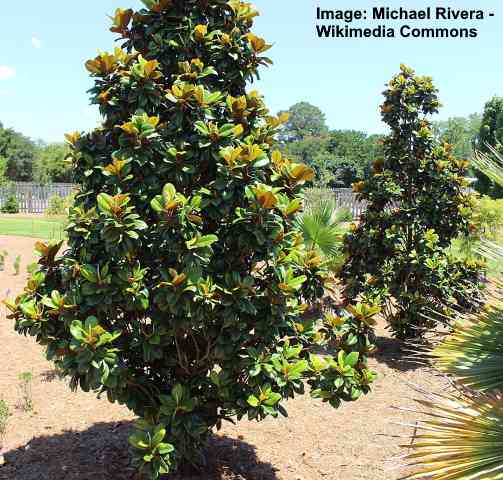
The southern magnolia ‘Teddy Bear’ is a popular dwarf magnolia cultivar
The magnolia ‘Teddy Bear’ is a compact, fast-growing, evergreen tree with creamy-white spring-blooming flowers. The dwarf magnolia is characterized by its large, glossy, dark green leaves with velvety, brown undersides. It has an upright form, compact growth, and conical shape. Its waxy, fragrant white flowers bloom until late summer.
The ‘Teddy Bear’ magnolia grows up to 20 ft. (6 m) tall, thriving in full sun and well-drained, moist soil. Thanks to its dwarf nature, the magnolia is ideal for small gardens and urban landscapes. You can plant the magnolia in subtropical landscapes as a focal tree in the front yard or as an evergreen hedge or privacy screen in backyards.
Its compact size and low maintenance requirements make it a popular choice among gardeners in southern states. The common name ‘Teddy Bear’ comes from the fuzzy brown undersides on the oval shaped leaves. It’s easy to differentiate from the ‘Little Gem’ cultivar due to its Christmas Tree shape.
- Bloom Time: From mid-spring to early fall
- Plant Size: 15 to 20 ft. (4.5 m – 6 m) tall and 7 to 10 ft. (2.1 – 3 m) wide
- USDA Plant Zone: 7 to 9
- Light: Full sun to partial shade
Susan Magnolia (Magnolia ‘Susan’)
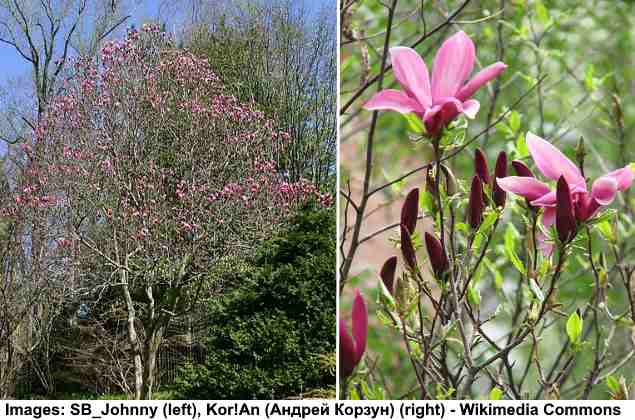
The Susan magnolia is a deciduous and cold hardy dwarf magnolia tree with pink flowers
Susan Magnolia is a slow-growing dwarf deciduous tree, reaching a maximum height of 12 ft. (3.6 m). Blooming in spring, ‘Susan’ magnolia offers beautiful, fragrant pink-purple flowers that add a burst of pinkish-red colors to spring and summer landscapes. This compact cultivar features narrow, cup-shaped pink blossoms with twisted petals, medium green ovate leaves, and attractive golden-yellow fall colors.
This hybrid deciduous magnolia blooms sporadically throughout summer in full sun or partial shade. Its dramatic pink flowers are ideal for adding color and fragrance to city gardens or as a small focal tree. This adaptable dwarf tree tolerates poorly-drained soils, partial shade, and clay or sandy soils.
Magnolia ‘Susan’ is one of the most cold-hardy magnolias, surviving in USDA Zone 4. It also blooms later than other magnolias, meaning it usually escapes frost damage in late spring. It is part of the “Little Girl” series of dwarf magnolia hybrids.
- Bloom Time: Spring and sporadically throughout summer
- Plant Size: 8 to 12 ft. (2.4 – 3.6 m) tall and wide
- USDA Plant Zone: 4 to 8
- Light: Full sun to partial shade
Magnolia ‘Ann’
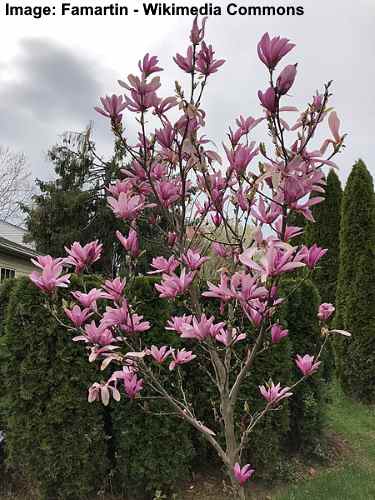
A magnolia ‘Ann’ dwarf tree
Magnolia ‘Ann’ is a compact deciduous tree blooming in mid to late spring with beautiful, fragrant, tulip-shaped pink flowers. The stunning magnolia has flowers in pinkish-purple shades, medium green, ovate leaves, and foliage that turns warm yellow in the fall. The ‘Ann’ magnolia is a compact tree with an upright, rounded form, ideal for smaller landscapes.
This magnolia variety ‘Ann’ grows up to 10 ft. (3 m) tall and wide. Its compact habit makes it ideal for filling compact gardens or tight spaces with dramatic spring blooms. The “Little Girl” ‘Ann’ magnolia hybrid also performs well as a specimen tree in cottage or city gardens.
- Bloom Time: Early spring and sporadically through summer
- Plant Size: 8 to 10 ft. (2.4 to 3 m) tall and wide
- USDA Plant Zone: 4 to 8
- Light: Full sun to partial shade
Magnolia ‘Black Tulip’ (Magnolia x soulangeana ‘Black Tulip’)
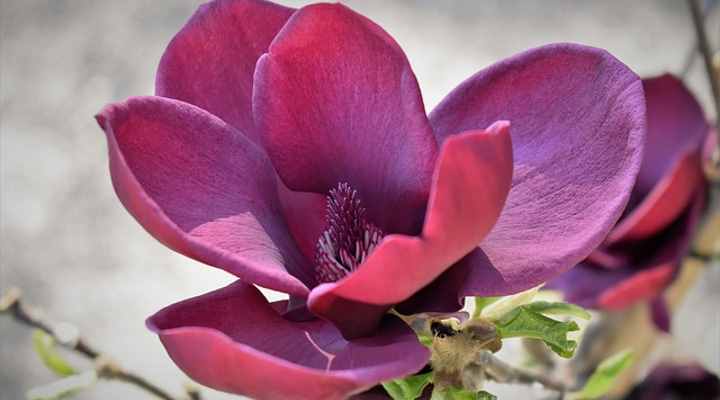
A close up picture of magnolia ‘Black Tulip’ (Magnolia x soulangeana ‘Black Tulip’) flower
The ‘Black Tulip’ magnolia is a stunning deciduous small tree with deep purple, tulip-shaped flowers. This compact magnolia variety blooms in early spring for several weeks. The goblet-like fragrant flowers measure 6” (15 cm) across and create a striking contrast with the dark green, obovate leaves, which are 8” (20 cm) long.
The dramatic burgundy aromatic flowers attract butterflies and bees to garden landscapes. The ‘Black Tulip’ magnolia tree’s narrow, upright habit makes it perfect for adding color and texture to smaller gardens and urban landscapes. This hybrid magnolia looks stunning as a specimen tree or planted in groups.
- Bloom Time: From early spring through summer
- Plant Size: 15 to 20 ft. (4.5 to 6 m) tall and 6 to 10 ft. (1.8 – 3 m) wide
- USDA Plant Zone: 5 to 9
- Light: Full sun to partial shade
Magnolia ‘Genie’
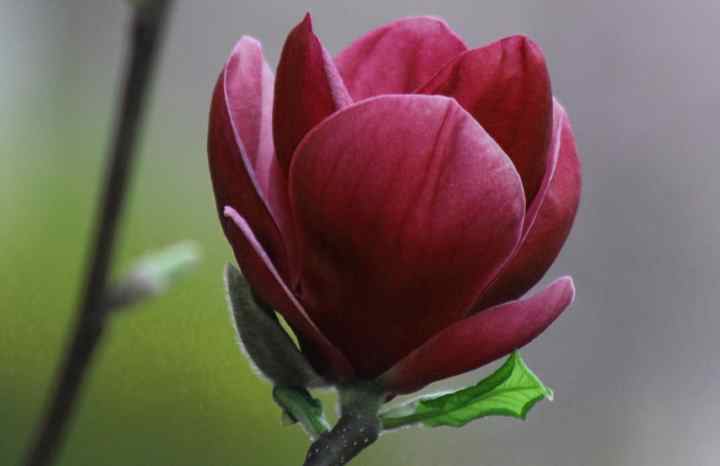
A Magnolia ‘Genie’ flower
The ‘Genie’ magnolia is an eye-catching deciduous tree with deep maroon-purple, tulip-shaped flowers. Blooming in mid-spring and off and on until late fall, the magnolia variety is known for its dramatic blooms, which are 6” (15 cm) across. The ‘Genie’ magnolia also has dark green, glossy leaves that provide an attractive backdrop for the vibrant flowers.
Growing up to 13 ft. (4 m) tall, the ‘Genie’ magnolia suits compact spaces or smaller gardens. It’s adaptable to various soil types but blooms best when the well-drained soil is consistently moist. Its compact size makes the ‘Genie’ magnolia suitable for container gardens.
- Bloom Time: Mid-spring and sporadically through fall
- Plant Size: 10 to 13 ft. (3 – 4 m) tall and 5 to 6 ft. (1.5 – 1.8 m) wide
- USDA Plant Zone: 5 to 9
- Light: Full sun to partial shade
Butterflies Magnolia (Magnolia ‘Butterflies’)
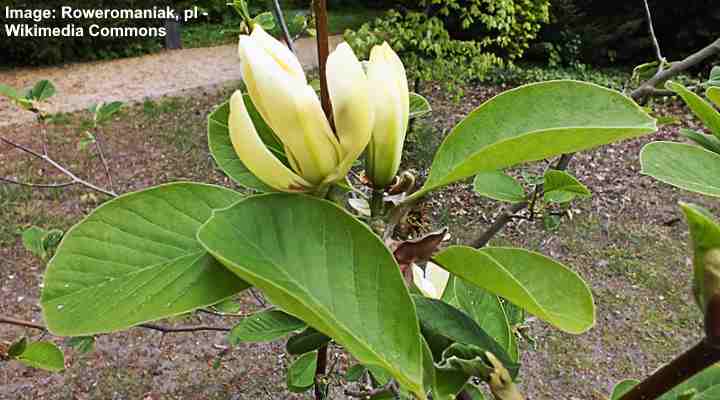
Magnolia Butterfly (Magnolia ‘Butterflies’) flowers and leaves
The ‘Butterflies’ magnolia is a deciduous tree that produces large, fragrant, yellow flowers in early spring. This magnolia variety has an upright, pyramidal habit, vibrant yellow butterfly-shaped blooms, and glossy green leaves that turn golden yellow in the fall. The early-spring blooming tree produces masses of flowers for several weeks.
Growing up to 20 ft. (6 m), the magnolia ‘Butterflies’ cultivar performs well in small gardens. Its bright flowers and lush foliage also create a beautiful focal point in a small yard.
- Bloom Time: Late winter or early spring
- Plant Size: 15 to 20 ft. (4.5 – 6 m) tall and 10 to 15 ft. (3 – 4.5 m) wide
- USDA Plant Zone: 5 to 9
- Light: Full sun to partial shade
Star Magnolia ‘Royal Star’ (Magnolia stellata ‘Royal Star’)
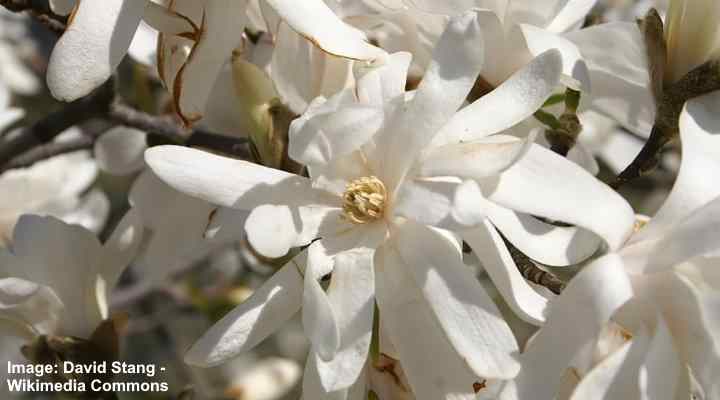
Royal Star magnolia is a small tree with star-shaped double white flowers
The ‘Royal Star’ magnolia is a small, deciduous tree that blooms in early spring with beautiful, star-shaped, white flowers. The large white flowers have narrow, elongated petals, creating a starburst effect. It blooms in early spring on bare branches before elliptic medium green leaves appear.
This compact magnolia variety is known for its multi-petaled blooms and dense, bushy growth habit. Its foliage also turns an attractive yellow shade in the fall, adding to its ornamental value.
Not growing taller than 20 ft. (6 m) tall, the magnolia cultivar is perfect for small gardens, courtyards, and urban landscapes. With regular pruning, it also works well as a specimen plant, in foundation plantings, or as part of a mixed border.
- Bloom Time: Early spring
- Plant Size: 10 to 20 ft. (3 – 6 m) tall and 8 to 15 ft. (2.4 – 4.5 m) wide
- USDA Plant Zone: 4 to 8
- Light: Full sun to partial shade
Magnolia ‘Pinkie’
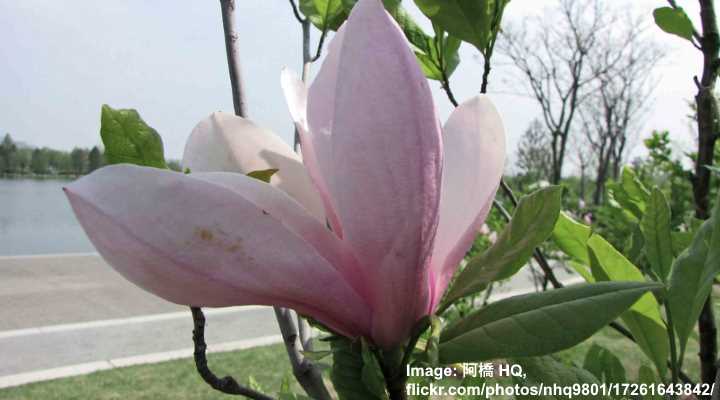
A close up image of magnolia ‘Pinkie’ flower
Magnolia’ Pinkie’ is a small, deciduous magnolia tree that produces stunning pale pink flowers in the spring. The magnolia’s cup-shaped flowers have 9 to 12 petals that fade from reddish-purple to light pink. Its pink flowers have a delicate fragrance and appear before the leaves unfurl. The large pink flowers measure 8” (20 cm) across.
Not growing taller than 15 ft. (4.5 m), the small, compact magnolia ‘Pinkie’ is ideal for planting where space is limited. You can use the dwarf tree as a focal point, foundation planting, or entryway accent. Its compact size also makes it perfect for planting in containers for a patio or decking area.
- Bloom Time: Late spring for several weeks
- Plant Size: 10 to 15 ft. (3 – 4.5 m) tall and 8 to 12 ft. (2.4 – 3.6 m) wide
- USDA Plant Zone: 5 to 8
- Light: Full sun or partial shade
Magnolia ‘Star Wars’
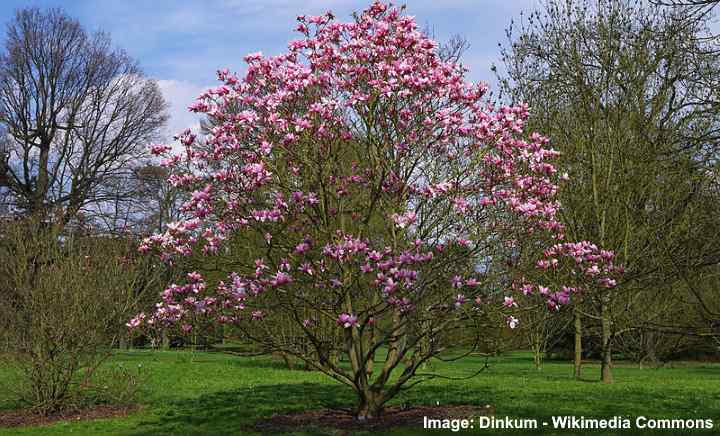
A magnolia ‘Star Wars’ tree
The magnolia’ Star Wars’ is a stunning deciduous magnolia tree with huge rosy-pink fragrant flowers. Blooming in mid to late spring for two months, the beautiful pink flowers measure 11” (28 cm) across. These contrast nicely with the glossy green leaves in early summer. This compact magnolia variety has an upright, pyramidal form, reaching up to 15 ft. (4.5 m) tall.
This magnolia ‘Star Wars’ thrives in full sun to partial shade and prefers well-drained, organically rich soil. In some cases, the dwarf tree produces a second flush of bright pink flowers in the fall. The ‘Star Wars’ magnolia is perfect for planting as a specimen tree or as part of a mixed border in gardens and landscapes.
- Bloom Time: Late spring for eight to ten weeks
- Plant Size: 10 to 15 ft. (3 – 4.5 m) tall and up to 20 ft. (6 m) wide
- USDA Plant Zone: 7 to 9
- Light: Full sun to partial shade
Magnolia ‘Ballerina’ (Magnolia × loebneri ‘Ballerina’)
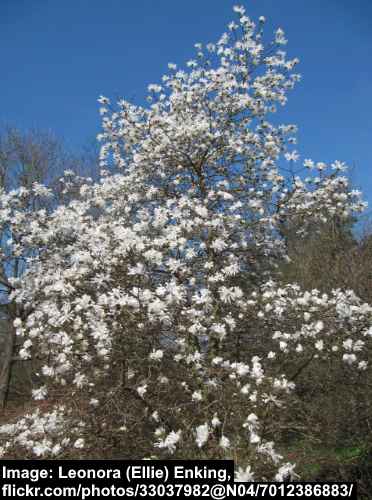
A magnolia ‘Ballerina’ (Loebner magnolia) tree
Also called the Loebner magnolia, this cultivar is a dwarf tree with fragrant, star-shaped white spring flowers. The white flowers have up to 30 petals and measure 4” to 6” (10 – 15 cm) across. This small magnolia has a narrow, upright growth habit with dense foliage of medium-green leaves.
The ‘Ballerina’ magnolia has attractive yellow fall colors, adding to its ornamental appeal. Also, the starry white flowers give way to red cone-like fruits that appear on the tree throughout summer. The magnolia ‘Ballerina’ is an ideal front lawn tree or low-growing shade tree for backyards.
- Bloom Time: Early spring
- Plant Size: 15 to 20 ft. (4.5 – 6 m) tall and wide
- USDA Plant Zone: 5 to 9
- Light: Full sun to partial shade
Magnolia ‘Vulcan’
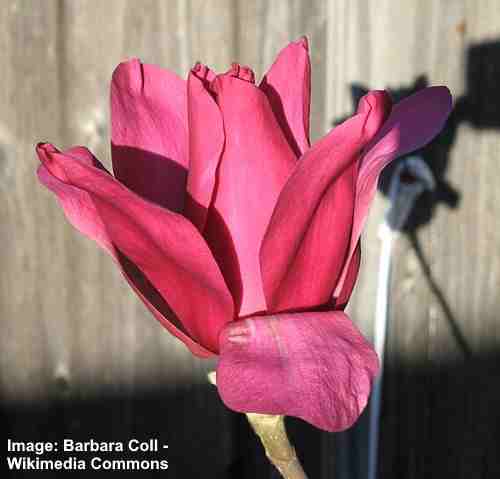
A magnolia ‘Vulcan’ flower
The magnolia ‘Vulcan’ blooms in mid-spring with deep pink-reddish cup-shaped fragrant flowers. The beautiful magnolia flowers emerge before the mid-green obovate leaves. The small, elegant tree has an upright, narrow habit up to 15 ft. (4.5 m) tall, and its glossy green leaves turn yellow in the fall.
The attractive ornamental feature of the ‘Vulcan’ magnolia is its stunning blossoms that become redder as the season progresses. Due to its small, compact growth, the shrub-like tree is perfect for smaller gardens or as a focal point in a larger landscape.
- Bloom Time: Early to mid-spring
- Plant Size: 10 to 15 ft. (3 – 4.5 m) tall and 8 to 10 ft. (2.4 – 3 m) wide
- USDA Plant Zone: 6 to 9
- Light: Full sun to partial shade
Magnolia ‘Chrysanthemumiflora’ (Magnolia stellata ‘Chrysanthemumiflora’)
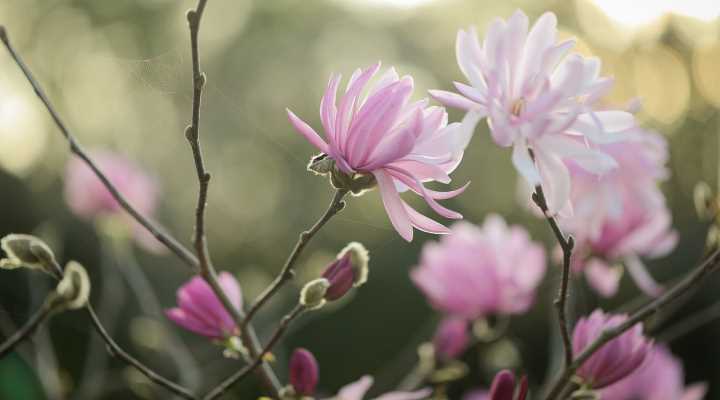
Magnolia ‘Chrysanthemumiflora’ flowers
The ‘Chrysanthemumiflora’ is a stunning deciduous shrub or small tree that produces large, showy flowers in early spring. The magnolia’s identifying feature is its attractive pink flowers resembling chrysanthemums. Not growing taller than 15 ft. (4.5 m), the attractive tree has lance-shaped mid-green leaves.
The ‘Chrysanthemumiflora’ is an excellent choice for smaller gardens thanks to its double blooms and compact nature. Its foliage is deer-resistant, and the fragrant blossoms attract pollinators like bees and butterflies, making it a great addition to garden landscapes.
- Bloom Time: Early spring to early summer
- Plant Size: 10 to 15 ft. (3 – 4.5 m) tall and wide
- USDA Plant Zone: 5 to 9
- Light: Full sun to partial shade
Magnolia ‘Encore’ (Magnolia loebneri ‘Encore’)
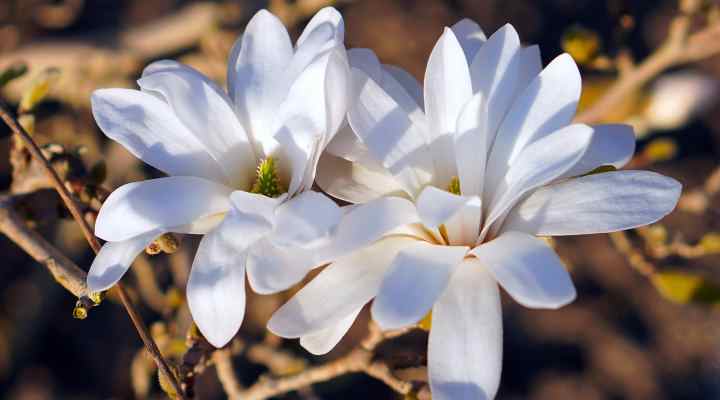
Magnolia loebneri ‘Encore’ flowers
The ‘Encore’ magnolia is a beautiful small tree with showy white flowers that appear in early spring. This magnolia cultivar has large, star-shaped white flowers and glossy dark green leaves. The deciduous foliage turns eye-catching yellow shades in the fall.
The ‘Encore’ magnolia grows up to 15 ft. (4.5 m) tall and wide. The bushy tree has a rounded, spreading habit, and its hardy blooms last a long time in spring and summer. The white-flowering magnolia looks spectacular in spring as a specimen plant, hedge, or privacy screen.
- Bloom Time: Early spring
- Plant Size: 8 to 15 ft. (2.4 – 4.5 m) tall and 6 to 15 ft. (1.8 – 4.5 m) wide
- USDA Plant Zone: 4 to 8
- Light: Full sun to partial shade
Magnolia ‘Nigra’ (Magnolia liliiflora ‘Nigra’)
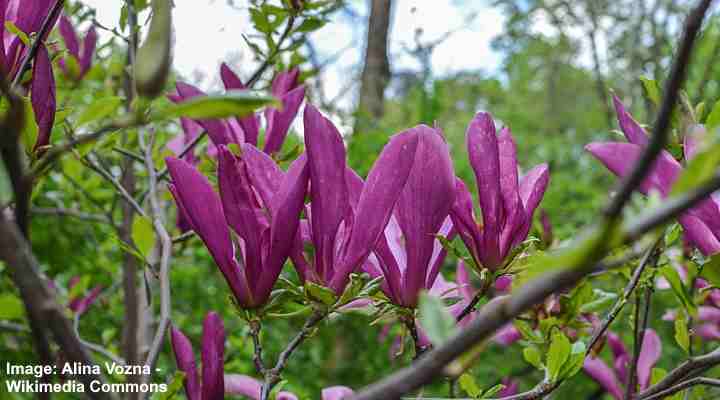
Magnolia liliiflora ‘Nigra’ flowers
The ‘Nigra’ magnolia tree is a dwarf, shrub-like tree known for its deep purple, tulip-shaped flowers. This compact magnolia blooms in early spring with vibrant dark-reddish-purple flowers. Its rounded crown has dense foliage consisting of glossy, dark green leaves that turn bronze in the fall. It may bloom sporadically throughout summer.
Growing up to 12 ft. (3.6 m) tall and wide, the dwarf ‘Nigra’ magnolia is an ideal specimen tree for compact garden landscapes. Its delicately fragrant flowers attract pollinators in early spring. It thrives in slightly acidic, organically rich, moist soils.
- Bloom Time: Early spring
- Plant Size: 8 to 12 ft. (2.4 – 3.6 m) tall and wide
- USDA Plant Zone: 5 to 9
- Light: Full sun to partial shade
Magnolia ‘Leonard Messel’ (Magnolia loebneri ‘Leonard Messel’)
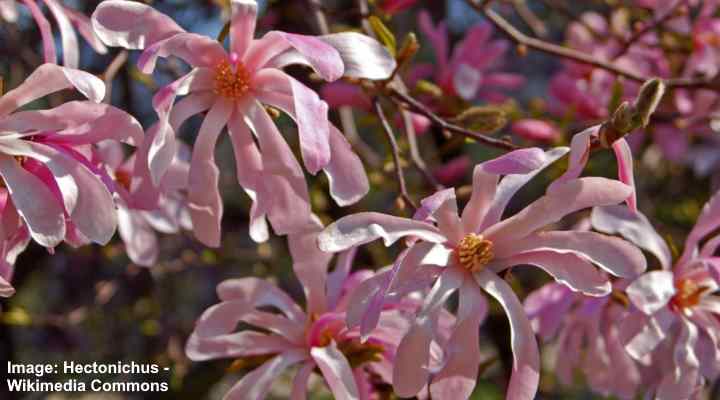
Magnolia loebneri ‘Leonard Messel’ flowers
The ‘Leonard Messel’ magnolia cultivar is a deciduous tree with stunning pale pink flowers blooming from early spring. The fragrant magnolia flowers have 12 strap-like light pink petals, narrow, ovate leaves, and a prolific blooming habit. The flowers measure 4” (10 cm) across and cover the dwarf tree in spring.
This magnolia tree doesn’t grow taller than 20 ft. (6 m). It has vigorous growth, and its showy rosy-pinkish flowers are relatively frost-tolerant. With its compact habit and multi-stemmed shrub-like growth, the pink-flowering magnolia tree performs well in landscapes with limited space.
- Bloom Time: Early to mid-spring
- Plant Size: 15 to 20 ft. (4.5 – 6 m) tall and 10 to 15 ft. (3 to 4.5 m) wide
- USDA Plant Zone: 5 to 9
- Light: Full sun to partial shade
Magnolia ‘Baby Grand’ (Magnolia grandiflora var. ‘STRgra’)
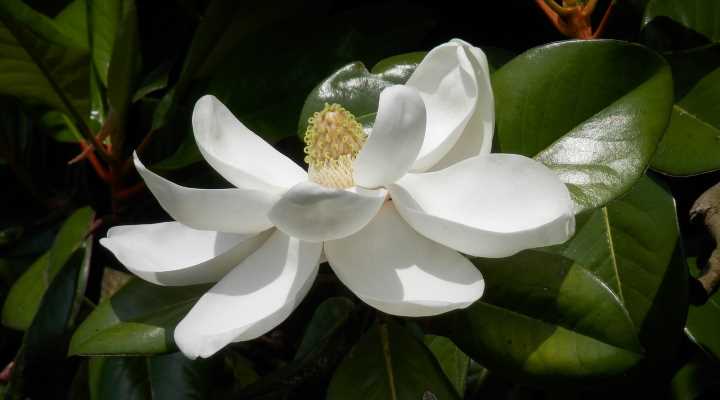
A magnolia ‘Baby Grand’ flower
The magnolia ‘Baby Grand’ is one of the smallest evergreen magnolia trees with large, fragrant white flowers. Its ornamental features include its thick, leathery, glossy green leaves, large, showy, cup-shaped white flowers, and a compact habit. The ‘Baby Grand’ magnolia blooms from late spring to early summer, and its lush evergreen foliage provides year-round interest.
This dwarf magnolia ‘Baby Grand’ doesn’t grow taller than 10 ft. (3 m). Its large white flowers have lemon fragrances that fill spring and summer landscapes with sweet aromas. The white-flowering tree works well in groupings, as an evergreen privacy hedge, or specimen tree.
- Bloom Time: Spring and summer
- Plant Size: 8 to 10 ft. (2.4 – 3 m) tall and wide
- USDA Plant Zone: 7 to 9
- Light: Full sun to partial shade
Saucer Magnolia ‘Alba Superba’ (Magnolia x soulangeana ‘Alba Superba’)
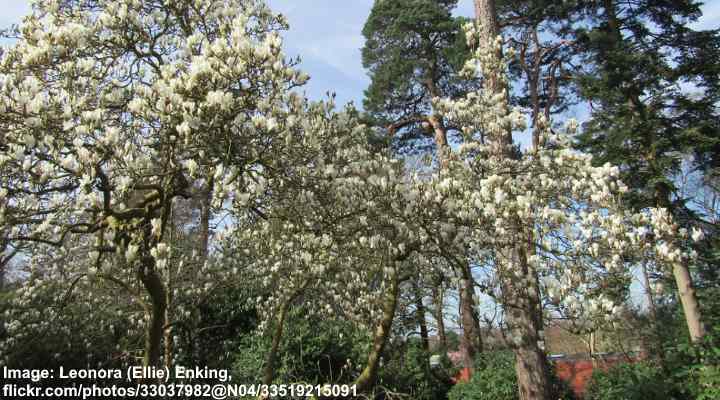
Saucer magnolia ‘Alba Superba’ trees
The saucer magnolia ‘Alba Superba’ cultivar is a small magnolia tree known for its large, showy, white tulip-like flowers. The fragrant flowers bloom on leafless branches and have upward-facing white petals with pink bases. The tree’s rounded, spreading habit and dwarf growth make it a great addition to smaller landscapes.
The magnolia’ Alba Superba’ doesn’t grow taller than 20 ft. (6 m) tall and wide. Thriving in full sun or partial shade, the dwarf saucer magnolia adds a touch of elegance to compact landscapes such as a specimen tree, privacy screen, or hedge.
- Bloom Time: From mid-spring through fall
- Plant Size: 15 to 20 ft. (4.5 – 6 m) tall and wide
- USDA Plant Zone: 6 to 9
- Light: Full sun to partial shade
Saucer Magnolia ‘Lennei’ (Magnolia x soulangeana ‘Lennei’)
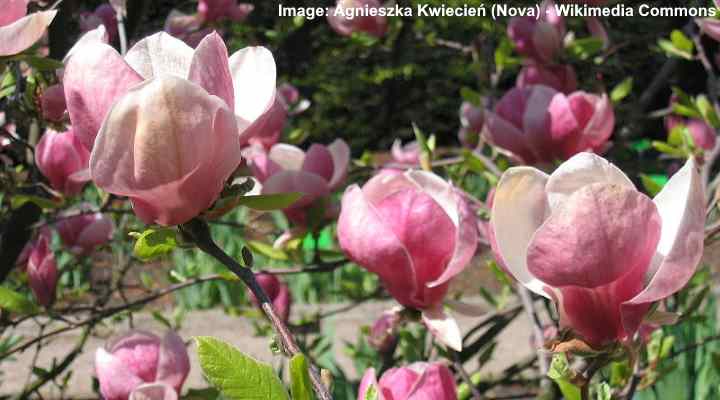
Saucer magnolia ‘Lennei’ flowers
Also called the Chinese magnolia, the ‘Lennei’ cultivar is a vigorous small tree that blooms with deep pink flowers every spring. This saucer magnolia cultivar has goblet-shaped flowers with dark pink outsides and white insides, creating a bicolor effect. Additionally, the blooms are highly fragrant and attract bees, butterflies, and other pollinators to compact gardens.
The ‘Lennei’ saucer magnolia can grow up to 20 ft. (6 m) tall. You can grow the multi-stemmed plant as a shrub or small tree. Apart from growing in the ground as a specimen plant, it performs well in planters in a container garden or patio.
- Bloom Time: Beginning in early spring and blooming sporadically until fall
- Plant Size: 15 to 20 ft. (4.5 to 6 m) tall and wide
- USDA Plant Zone: 6 to 9
- Light: Full sun to partial shade
Tulip Magnolia ‘Lilliputian’ (Magnolia x soulangeana ‘Lilliputian’)
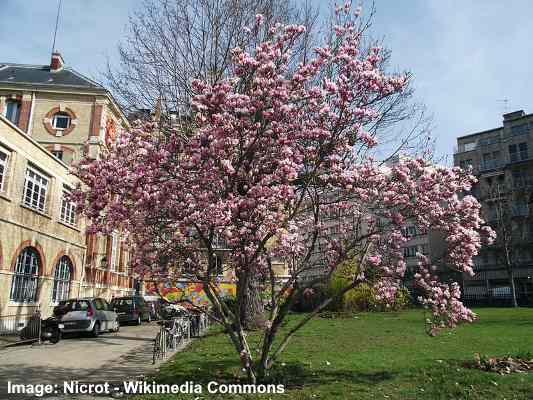
Saucer Magnolia ‘Lilliputian’ (Magnolia soulangeana ‘Lilliputian’)
The tulip magnolia ‘Lilliputian’ is one of the smallest magnolia trees for compact gardens. The shrub-like tree has beautiful, citrus-scented, fragrant, pinkish tulip-shaped flowers blooming in early spring. This compact magnolia cultivar has a bushy growth habit with dense foliage of dark green, ovate leaves.
The ‘Lilliputian’ magnolia grows up to 12 ft. (3.6 m) tall, making it perfect for growing in smaller gardens as a focal point. The dwarf magnolia blooms the best in full sun and well-drained soil. Its goblet-shaped pale pink flowers enhance the aesthetics of any compact garden space.
- Bloom Time: Early spring through to fall
- Plant Size: 10 to 12 ft. (3 – 3.6 m) tall and wide
- USDA Plant Zone: 5 to 9
- Light: Full sun to partial shade
Oyama Magnolia (Magnolia sieboldii)
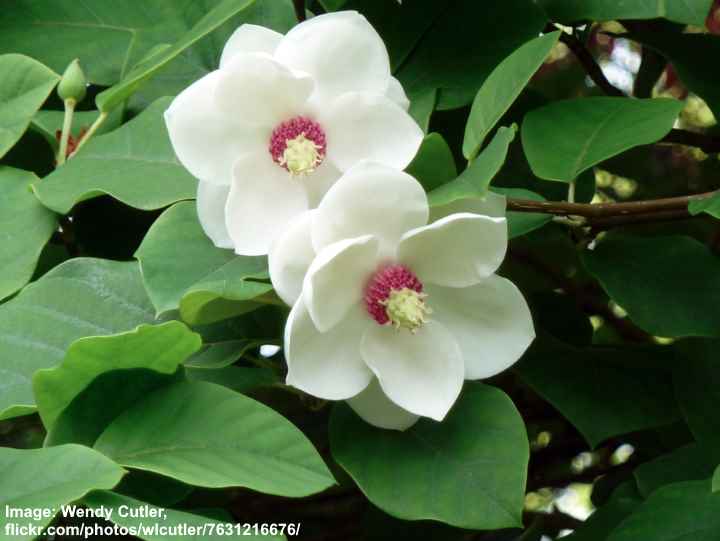
Oyama magnolia (Magnolia sieboldii) flowers
The stunning Oyama magnolia is a dwarf deciduous magnolia tree native to Japan. The small magnolia is characterized by its large, fragrant, white, cup-shaped flowers emerging from egg-shaped buds in late spring. The broad, elliptic green leaves create dense foliage. Its fragrant flowers are 4” (10 cm) across, and the leaves measure 6” (15 cm) long.
The dwarf Oyama magnolia turns beautiful golden yellow shades in the fall. The small shrub-like tree features a rounded, spreading habit and grows up to 15 ft. (4.5 m) tall and wide. The Oyama magnolia is a hardy ornamental tree well-suited to growing in gardens and landscapes with limited space.
Also, the sweet, floral fragrances of its creamy-white, nodding flowers enhance the ambiance of patios and decks when growing in containers.
- Bloom Time: Early spring through early summer
- Plant Size: 10 to 15 ft. (3 – 4.5 m) tall and wide
- USDA Plant Zone: 6 to 9
- Light: Full sun to partial shade
Evergreen Magnolia ‘Kay Parris’ (Magnolia grandiflora ‘Kay Parris’)
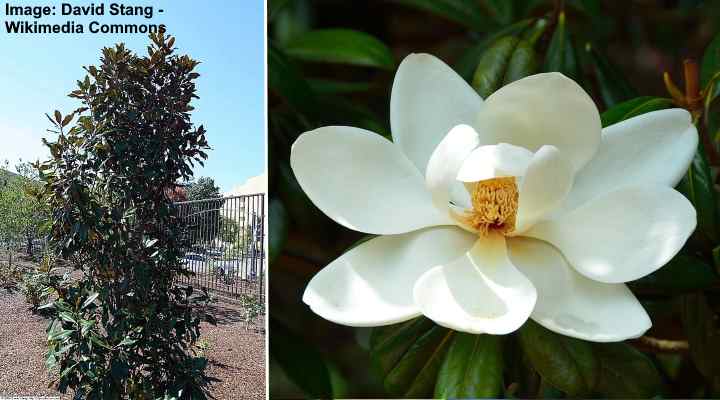
A magnolia ‘Kay Parris’ tree and flower
The ‘Kay Parris’ dwarf magnolia is one of the most stunning ornamental evergreen trees with white flowers. The hardy tree has brilliant white flowers, spring blooming time, leathery leaves with wavy margins, and cone-like seed pods. The white-flowering evergreen tree has strong floral scents when in bloom from late spring through fall.
This dwarf magnolia ‘Kay Parris’ has a pyramidal form and dense foliage. Its leaves have a velvet bronze underside, adding to the tree’s unique appearance. The stunning evergreen magnolia is ideal as a shade tree, living screen, or hedge.
- Bloom Time: Late spring to early summer and sporadically throughout the year
- Plant Size: 15 to 20 ft. (4.5 – 6 m) tall and 8 to 10 ft. (2.4 – 3 m) wide
- USDA Plant Zone: 6 to 9
- Light: Full sun to partial shade
Star Magnolia ‘Centennial’ (Magnolia stellata ‘Centennial’)
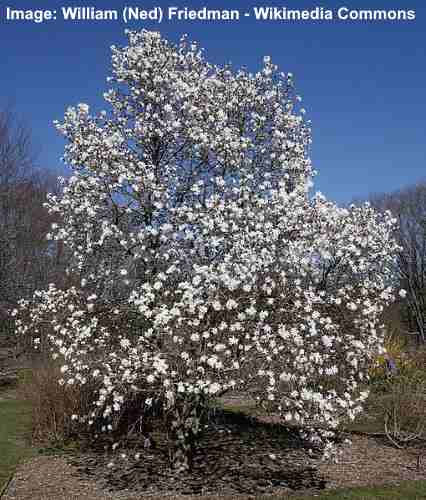
A star magnolia ‘Centennial’ tree
The ‘Centennial’ star magnolia is a deciduous shrub or small tree that blooms in early spring. The dwarf magnolia tree is known for its fragrant white flowers that resemble water lilies measuring 5.5” (14 cm) across. They bloom on leafless stems in early spring before medium-green leaves appear.
The compact magnolia has a broadly pyramidal habit and grows up to 20 ft. (6 m) tall and wide. The ‘Centennial’ magnolia cultivar thrives in full sun and well-drained, slightly acidic soil, ideal for small front or backyards. You can plant the small-growing magnolia tree as a focal point in the landscape.
- Bloom Time: Early to mid-spring
- Plant Size: 15 to 20 ft. (4.5 – 6 m) tall and wide
- USDA Plant Zone: 4 to 9
- Light: Full sun to partial shade
Star Magnolia ‘Jane Platt’ (Magnolia stellata ‘Jane Platt’)
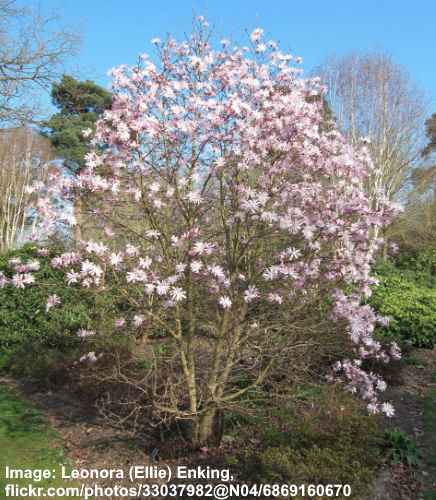
A star magnolia ‘Jane Platt’ tree
The star magnolia ‘Jane Platt’ is a small magnolia tree that blooms in early spring with showy pale pink flowers. The pretty blooms are double, heavily scented flowers measuring 4” (10 cm) across. ‘Jane Platt’ magnolia also has a broadly conical shape and grows up to 15 ft. (4.5 m) tall.
This magnolia cultivar is cold-hardy to zone 4, making it suitable for landscaping small gardens in colder climates. Its low growth, narrow spread, and beautiful fragrant flowers make ‘Jane Platt’ magnolias a stunning addition to gardens with limited space. Its early spring blooms give the landscape a burst of color and fragrance.
- Bloom Time: Early to mid-spring
- Plant Size: 10 to 15 ft. (3 to 4.5 m) tall and 8 to 12 ft. (2.4 to 3.6 m) wide
- USDA Plant Zone: 4 to 8
- Light: Full sun to partial shade
Sprenger’s Magnolia ‘Copeland Court’ (Magnolia sprengeri var. diva ‘Copeland Court’)
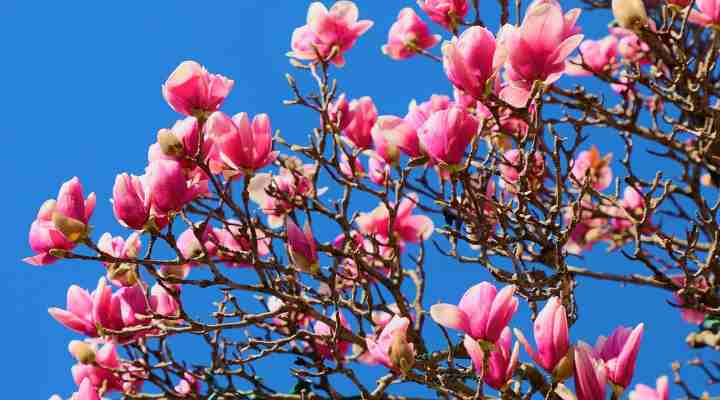
Sprenger’s magnolia ‘Copeland Court’ flowers
The ‘Copeland Court’ Sprenger’s Magnolia is a small deciduous tree with beautiful tulip-shaped, rich, pink flowers. Blooming in early spring, the pink, showy, goblet-shaped blossoms are some of the most abundant on all magnolia trees. The dark green, glossy leaves with silvery undersides add to the tree’s charm.
This magnolia is perfect for adding a splash of spring pink shades to smaller gardens or compact landscapes. The ‘Copeland Court’ cultivar is ideal for planting in colder climates. Also, its late blooming time means it usually escapes late frosts. You can plant it as a specimen tree to enjoy its stunning large pink flowers in late spring and early summer.
- Bloom Time: Mid-spring to early summer
- Plant Size: 15 to 25 ft. (4.5 – 7.6 m) tall and wide
- USDA Plant Zone: 5 to 8
- Light: Full sun to partial shade
Magnolia ‘Gold Star’ (Magnolia stellata ‘Gold Star’)
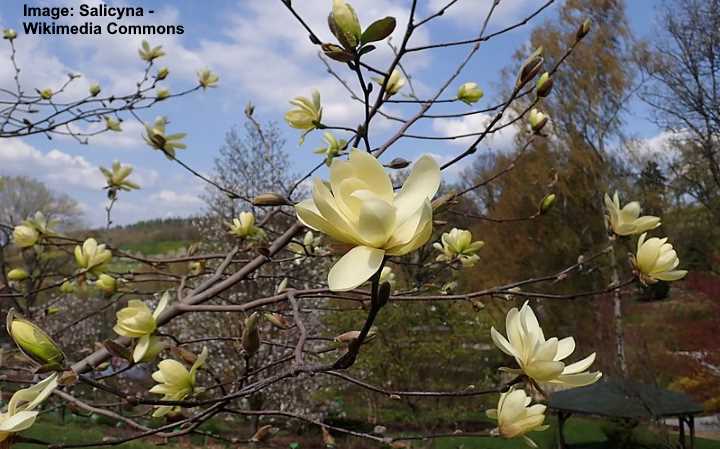
Magnolia ‘Gold Star’ flowers
The ‘Gold Star’ magnolia is a compact, deciduous magnolia tree with star-shaped, fragrant, creamy-yellow flowers. This dwarf magnolia cultivar is known for its early spring blooms, appearing before the leaves emerge. The ‘Gold Star’ magnolia is a small, bushy tree with a broad pyramidal habit. Its dark green foliage turns yellow in the fall.
Growing up to 25 ft. (7.6 m) tall and wide, the ‘Gold Star’ magnolia is perfect for small to midsize gardens and urban landscapes. It thrives in full sun to partial shade and well-drained, organically rich soil. You can plant this magnolia variety as a specimen tree or accent plant.
- Bloom Time: Early spring
- Plant Size: 15 to 25 ft. (4.5 – 7.6 m) tall and up to 20 ft. (6 m) wide
- USDA Plant Zone: 5 to 9
- Light: Full sun to partial shade
Magnolia ‘Miss Honeybee’ (Magnolia acuminata var. subcordata ‘Miss Honeybee’)
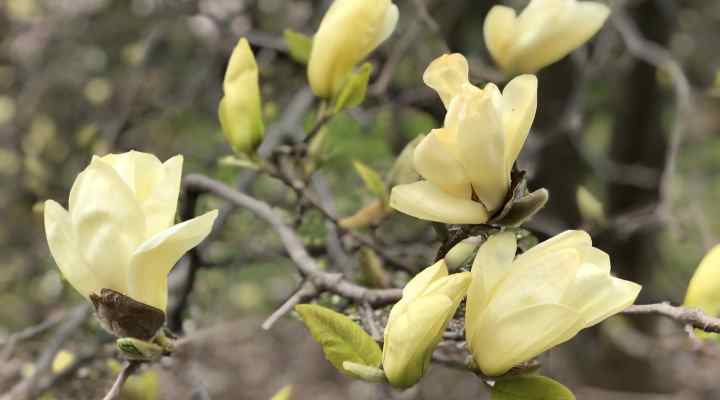
Magnolia ‘Miss Honeybee’ flowers
Also called the cucumber tree, the ‘Miss Honeybee’ magnolia is a small deciduous cultivar with pale yellow, cup-shaped flowers. Blooming in April and May, the small tree produces dark green, leathery leaves 7” (18 cm) long and cucumber-shaped fruits follow its flowers. The fragrant, nectar-rich blooms attract bees and other pollinators.
This magnolia ‘Miss Honeybee’ grows up to 25 ft. (7.6 m) tall. You can plant it as a specimen tree, in a mixed border, or as a tall screen or hedge. It’s one of the few magnolia trees that performs well as a lawn and shade tree.
- Bloom Time: Early to mid-spring
- Plant Size: 20 to 25 ft. (6 – 7.6 m) tall and 15 to 20 ft. (4.5 – 6 m) wide
- USDA Plant Zone: 5 to 8
- Light: Full sun to partial shade
Magnolia ‘Sunsation’
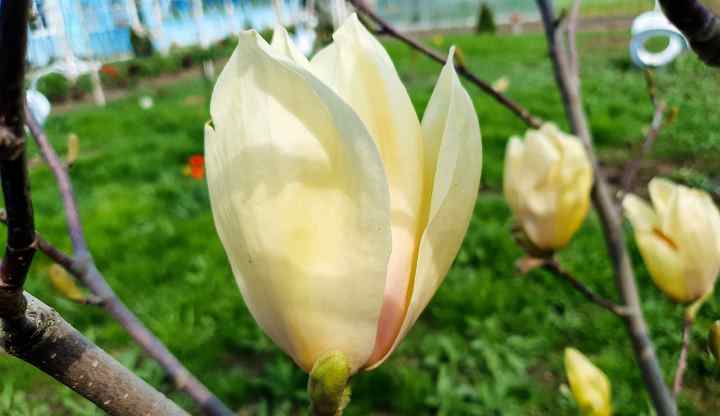
Magnolia ‘Sunsation’ flowers
The small ‘Sunsation’ magnolia tree blooms in mid to late spring with abundant yellow flowers with pink tinge at the base. The large upright yellow flowers measure 7” (18 cm) across, and the petals have a rosy-pink base. This hybrid magnolia has an upright, pyramidal shape and dense foliage consisting of dark green, ovate leaves.
Growing up to 25 ft. (7.6 m) tall, the ‘Sunsation’ magnolia is a beautiful addition to small or medium-sized garden landscapes. It fills spring gardens with color and sweet fragrances. In summer, its dense foliage shades gardens and has attractive yellow fall colors before the leaves drop. Also, its narrow spread makes it perfect for planting in compact spaces.
- Bloom Time: Mid to late spring
- Plant Size: 20 to 25 ft. (6 – 7.6 m) tall and 6 to 8 ft. (1.8 – 2.4 m) wide
- USDA Plant Zone: 5 to 8
- Light: Full sun to partial shade
Growing Dwarf Magnolia Trees – FAQ
What month is best to plant a magnolia tree?
The best month to plant a magnolia tree depends on the magnolia variety and your climate. In cold climates, plant magnolia trees in early spring when the weather is mild, and the risk of frost has passed. In warmer climates, plant magnolias in late fall or winter. It’s best to plant evergreen magnolias in spring.
Do dwarf magnolia trees have invasive roots?
Dwarf magnolia trees do not have invasive roots. Although the roots spread vigorously, they are not considered invasive. Dwarf magnolias have a deep taproot and shallow root system spreading about four times the canopy side. However, it would be best not to plant dwarf magnolia trees too close to your house.
What is the best magnolia tree for a small garden?
The southern magnolia ‘Little Gem’ cultivar is the best tree for a small garden. This compact dwarf tree grows 15 to 20 ft. (4.5 – 6 m) and has all the ornamental features of larger magnolias. It has large, showy, fragrant white blooms and glossy, leathery foliage that fits nicely into a limited space.
How do I fertilize my dwarf magnolia tree?
Fertilizing your dwarf magnolia tree is important to its health and excellent growth. Use a multi-purpose flowering tree fertilizer with an NPK rating of 10-10-10. Apply four times a year from late April to mid-July.
Are dwarf magnolias resistant to pests and diseases?
Yes, generally, dwarf magnolias are resistant to pests and diseases. For example, the ever-popular ‘Little Gem’ and ‘Teddy Bear’ dwarf magnolia trees tolerate salt, drought, and deer. Also, they generally have few issues with pests. However, poor growing conditions can mean that common pests like aphids, scale insects, caterpillars, and borers can impact magnolia tree growth.
How fast do dwarf magnolia trees grow?
Dwarf magnolia trees are typically moderate to fast-growing trees. Most dwarf cultivars grow at a rate of 12” to 18” (40 – 45 cm) annually. Their limited height and compact nature make them ideal for small landscapes or garden areas where space is limited.
Can I grow dwarf magnolias in colder climates?
Some dwarf magnolias are suitable for growing in colder climates. Dwarf magnolias suitable for USDA zones 4 and 5 include the following cultivars:
- Magnolia ‘Ann’ (Zones 4 to 8)
- Magnolia ‘Susan’ (Zones 4 to 8)
- Magnolia’ Black Tulip’ (Zones 5 to 9)
- Magnolia ‘Genie’ (Zones 5 to 9)
- Magnolia x loebneri ‘Encore’ (Zones 4 to 8)
- Saucer magnolia ‘Lilliputian’ (Zones 5 to 9)
Related articles:
